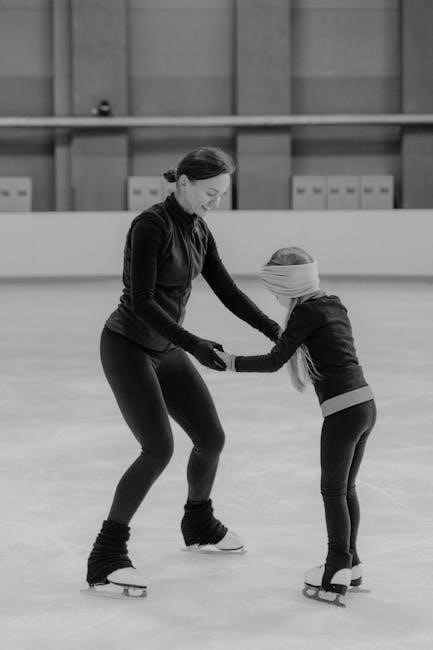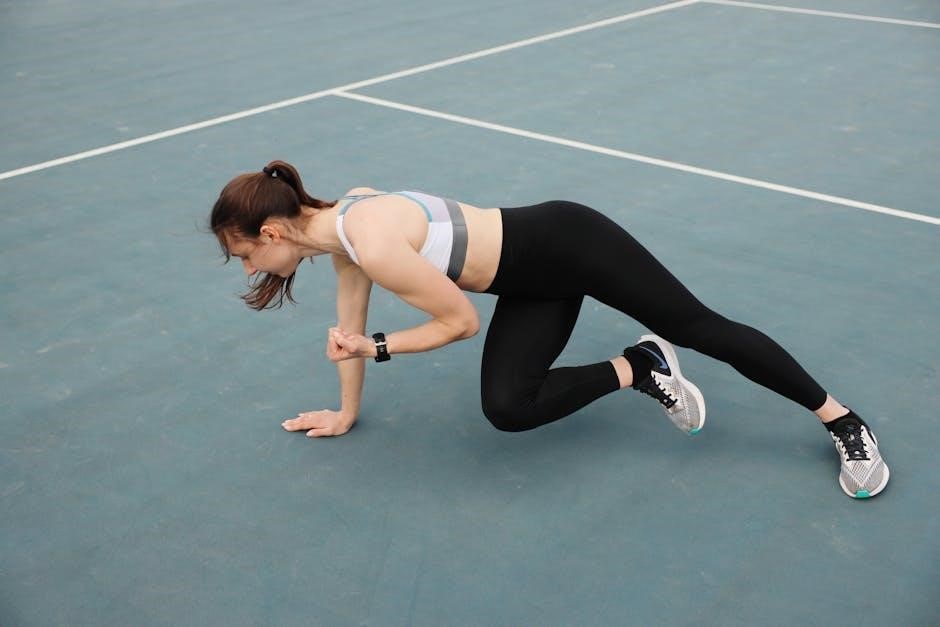Cervical fusion exercises are essential for recovery after neck surgery, focusing on mobility, strength, and stability․ They help restore function and prevent further injury, promoting a full recovery․
What is Cervical Fusion?

A cervical fusion is a surgical procedure designed to join two or more vertebrae in the neck, stabilizing the spine and preventing movement between the bones․ This is typically achieved using bone grafts, metal plates, or screws to promote healing and fusion of the vertebrae․ The primary goal of cervical fusion is to alleviate pain, address instability, or decompress nerves and the spinal cord․ It is commonly used to treat conditions such as herniated discs, spinal stenosis, or fractures․ The procedure can be performed anteriorly (front) or posteriorly (back), depending on the patient’s condition․ Proper post-operative care and exercises are crucial for optimal recovery and long-term spinal health․
Purpose of Cervical Fusion Exercises
The primary purpose of cervical fusion exercises is to enhance recovery after surgery by improving neck mobility, strength, and spinal stability․ These exercises aim to restore functional movement, reduce pain, and prevent further injury․ They are designed to promote proper healing of the fused vertebrae while maintaining flexibility and strength in the surrounding muscles․ Additionally, these exercises help patients gradually return to daily activities and improve overall posture and body mechanics․ Consistency in performing these exercises is key to achieving optimal outcomes and ensuring long-term spinal health․ They are tailored to progress safely through different recovery phases, addressing both physical and functional needs․
Types of Cervical Fusion Surgeries
Cervical fusion surgeries are categorized into two main types: anterior and posterior․ Anterior cervical fusion involves accessing the spine through the front of the neck, often using bone grafts and metal hardware to stabilize the vertebrae․ Posterior cervical fusion, on the other hand, is performed through the back of the neck, typically using rods and screws for added stability․ Both methods aim to fuse the affected vertebrae to alleviate pain and instability․ The choice of surgery depends on the patient’s condition, such as the location of the injury or degeneration․ These procedures are often combined with spinal decompression to relieve pressure on the spinal cord or nerves, ensuring proper alignment and stabilization of the cervical spine․

Post-Operative Recovery and Precautions
After cervical fusion surgery, patients must wear a cervical collar for 4-6 weeks and avoid heavy lifting, bending, or overhead activities to ensure proper healing and prevent complications․
Immediate Post-Surgery Care
Immediately after cervical fusion surgery, patients require close monitoring to manage pain, reduce swelling, and ensure proper wound healing․ Pain relief medications are typically prescribed to alleviate discomfort during the initial recovery phase․ Swelling can be minimized by elevating the head of the bed using pillows or a recliner․ Patients are advised to avoid heavy lifting, bending, or twisting to protect the fusion site․ A cervical collar is usually worn full-time for the first 4-6 weeks to stabilize the neck․ Additionally, patients should keep the surgical site clean and dry to prevent infection, avoiding submerging the wound in water until fully healed․ Regular follow-ups with the surgeon are essential to monitor progress and address any concerns promptly․
Cervical Collar Usage Guidelines
A cervical collar is essential for stabilizing the neck after fusion surgery․ It should be worn full-time for the first 4-6 weeks and at night for up to 12 weeks․ Proper fitting is crucial to avoid skin breakdown; ensure the collar is snug but not overly tight․ Patients should remove the collar briefly daily to inspect the skin and allow it to breathe․ Different types of collars, such as soft, medium, or rigid, may be prescribed based on the surgeon’s recommendations․ It is important to follow specific guidelines for collar use, as improper wear can hinder recovery or cause discomfort․ Always consult your surgeon for adjustments or concerns regarding collar usage․
Activity Restrictions After Surgery
After cervical fusion surgery, activity restrictions are crucial to ensure proper healing and fusion of the vertebrae․ Patients should avoid heavy lifting, bending, or twisting for the first 12 weeks․ Activities requiring overhead reaching or repetitive neck movements are also restricted․ Driving is permitted only after discontinuing narcotic pain medication and with surgeon approval․ Light activities, such as short walks and gentle stretching, are encouraged but must be done without jeopardizing the cervical spine’s stability․ Lifting should be limited to less than 5 pounds initially, gradually increasing as healing progresses․ Adhering to these restrictions minimizes the risk of complications and supports optimal recovery outcomes․ Consistency in following these guidelines is key to achieving long-term stability and function․

Understanding Exercise Phases
Cervical fusion exercises are divided into phases to ensure safe and effective recovery․ Each phase targets specific goals, from minimizing strain to rebuilding strength and mobility․
Phase 1: Immediate Post-Surgery Exercises
Phase 1 focuses on gentle, low-impact exercises to promote healing and minimize strain on the cervical spine․ These exercises are typically performed 2-4 weeks post-surgery and include deep breathing, chin tucks, and shoulder rolls․ The goal is to maintain mobility without compromising the fusion site․ Patients are advised to avoid heavy lifting or bending․ Gentle neck stretches and isometric exercises, like pressing the head against a pillow, are often recommended․ These activities help improve blood flow and reduce stiffness while adhering to post-operative restrictions․ Consistency is key to laying a strong foundation for recovery and preventing complications․
Phase 2: Intermediate Recovery Exercises
Phase 2 begins 4-6 weeks post-surgery, focusing on gradually increasing strength and mobility․ Exercises include gentle neck stretches, shoulder blade squeezes, and light resistance bands for shoulder and arm movements․ Patients are encouraged to perform isometric exercises like head turns and chin tucks with resistance․ Core strengthening, such as planks and bridges, is introduced to support spinal stability․ Light cardio, like walking or stationary biking, is also recommended․ These exercises aim to improve range of motion and rebuild muscle strength without overstraining the cervical spine․ Progression is slow and controlled, ensuring the fusion site remains stable while enhancing overall recovery and functional ability․
Phase 3: Advanced Strengthening Exercises
Phase 3, typically starting 3-6 months post-surgery, focuses on advanced strengthening to restore full functional ability․ Exercises include resistance band workouts for neck and shoulder muscles, dynamic stretches, and progressed isometric exercises․ Patients may perform planks, bird-dog exercises, and core stabilization drills to enhance spinal stability․ Light weight training for shoulders and arms is introduced, avoiding overhead activities․ Emphasis is placed on improving endurance and strength while maintaining proper cervical alignment․ These exercises prepare individuals for daily activities and long-term spinal health․ Supervision by a physical therapist ensures safe progression, tailoring exercises to individual recovery stages and fusion stability․

Specific Exercises for Cervical Fusion Recovery
Exercises include gentle neck and shoulder mobility, isometric strengthening, and core stabilization․ These are tailored to promote healing, restore flexibility, and strengthen muscles around the cervical spine․
Gentle Neck and Shoulder Mobility Exercises
Gentle neck and shoulder mobility exercises are crucial during the early stages of recovery after cervical fusion surgery․ These exercises focus on improving range of motion without putting strain on the surgical site․ Patients are often advised to perform chin tucks, shoulder rolls, and side-to-side neck movements while maintaining a pain-free range․ It is important to avoid any twisting or heavy lifting․ These exercises help prevent stiffness and promote proper healing of the cervical spine․ Consistency is key, as they lay the foundation for more advanced movements in later recovery phases․ Always consult a healthcare provider before starting any exercise program․
Isometric and Strengthening Exercises
Isometric and strengthening exercises are introduced in later recovery phases to build muscle endurance and stability around the cervical spine․ These exercises involve gentle resistance, such as pressing the head against the hand or using resistance bands for shoulder movements․ They are designed to enhance the strength of the neck and shoulder muscles without risking injury․ Patients are encouraged to perform these exercises slowly and within a pain-free range․ Deep breathing is often incorporated to maintain proper posture and reduce tension․ These exercises are essential for restoring functional strength and preparing the patient for daily activities and more advanced movements․
Core and Spinal Stabilization Exercises
Core and spinal stabilization exercises are crucial for improving postural control and reducing strain on the cervical spine․ These exercises focus on engaging the transverse abdominis muscle through techniques like abdominal bracing․ Patients perform activities such as planks, bridges, and pelvic tilts with cervical spine support․ Neutral spine positioning is emphasized to minimize stress on the fusion site․ Gentle movements, like pelvic tilts and cat-cow stretches, are also included to enhance spinal flexibility without risking injury․ These exercises help restore balance, reduce pain, and promote long-term spinal stability, ensuring a stronger foundation for the neck and overall spine․

Rehabilitation and Physical Therapy
Physical therapy plays a vital role in cervical fusion recovery, focusing on restoring strength, flexibility, and proper spinal alignment through targeted exercises and manual therapy techniques․
Role of Physical Therapy in Recovery
Physical therapy is crucial for cervical fusion recovery, guiding patients through structured exercises to enhance neck mobility, strengthen muscles, and improve posture․ Therapists design personalized programs to address pain, restore function, and prevent future injuries․ They use techniques like manual therapy, isometric exercises, and aquatic therapy to promote healing and stability․ Patient education on proper body mechanics and activity modifications is also a key component, ensuring safe and effective recovery․ Regular sessions help monitor progress and adjust exercises as needed, fostering a comprehensive return to daily activities and optimal spinal health․
Progression of Exercises Over Time
Exercises after cervical fusion progress through phases, starting with gentle movements and gradually increasing intensity․ Initially, focus is on pain-free range of motion and isometric strengthening․ As healing advances, exercises target deeper neck muscles and spinal stabilization․ Phase 1 emphasizes basic mobility like chin tucks and shoulder rolls․ Phase 2 introduces resistance bands and core engagement․ Phase 3 focuses on advanced strengthening, such as planks and dynamic movements․ Each progression is tailored to individual healing, ensuring proper form and avoiding overexertion․ Supervised physical therapy guides this process, adapting exercises to promote optimal recovery and long-term spinal health without compromising the fusion site․
Aquatic Therapy for Cervical Fusion Recovery
Aquatic therapy is a beneficial adjunct to traditional rehabilitation for cervical fusion recovery․ The buoyancy of water reduces spinal stress, allowing for gentle, pain-free movements․ Exercises in water focus on stabilization, balance, and strength without overstraining the neck․ Patients often perform standing exercises, leg movements, and controlled arm exercises to enhance core stability and spinal alignment․ Aquatic therapy also promotes relaxation and reduces muscle tension, aiding in overall recovery․ It is typically introduced in later recovery phases, under professional guidance, to complement land-based exercises and accelerate progress toward full mobility and strength․

Lifestyle Adjustments for Recovery
Lifestyle adjustments are crucial for optimal recovery after cervical fusion․ Proper sleep positioning, postural awareness, and a balanced diet support healing․ Avoid smoking and heavy lifting to enhance recovery and overall well-being․
Proper Sleep Positioning
Proper sleep positioning is vital for recovery after cervical fusion surgery․ Patients are advised to sleep on their back or side, using supportive pillows to maintain spinal alignment․ A cervical collar may be recommended to wear at night for added stability․ Elevating the head of the bed by 30 degrees using pillows or a recliner can reduce swelling and discomfort․ Avoid sleeping on your stomach, as it can strain the cervical spine․ Consistent use of recommended sleep positions helps promote healing, reduces pain, and prevents complications․ Proper sleep hygiene, combined with a supportive mattress, ensures optimal recovery and comfort during the healing process․
Postural Education and Body Mechanics
Postural education and proper body mechanics are crucial for cervical fusion recovery․ Patients should maintain a neutral spine alignment during sitting, standing, and moving․ Using a lumbar roll can support proper sitting posture․ Avoid prolonged flexion, such as looking down at screens, and take frequent breaks to change positions․ When lifting, use leg strength instead of the neck or back, and keep objects close to the body․ Driving is allowed once off pain medications and out of the collar․ Education on activities of daily living ensures safe movements, preventing strain on the cervical spine and promoting a smooth recovery․
Nutrition and Overall Health
Nutrition plays a vital role in cervical fusion recovery, supporting bone healing and overall well-being․ A balanced diet rich in calcium, vitamin D, and protein aids bone graft integration․ Anti-inflammatory foods, such as omega-3 rich fish and antioxidants, reduce swelling․ Hydration is essential for tissue repair․ Smoking and excessive alcohol should be avoided to prevent healing delays․ Maintaining a healthy weight reduces strain on the spine․ Proper nutrition complements exercises, promoting faster recovery and long-term spinal health․ Consulting a nutritionist can help tailor dietary plans for individual needs, ensuring optimal recovery outcomes after cervical fusion surgery․
Cervical fusion exercises are crucial for recovery, promoting healing, strength, and mobility․ Consistency ensures optimal outcomes, reducing pain and enhancing long-term spinal health effectively․
Importance of Consistency in Exercise
Consistency in performing cervical fusion exercises is vital for optimal recovery․ Regular practice ensures gradual healing, strengthens muscles, and restores function․ It prevents re-injury and enhances spinal stability, reducing pain over time․ Patients who adhere to their exercise routines often achieve better long-term outcomes, with improved mobility and reduced discomfort․ Consistency also helps in rebuilding the strength of the neck and shoulder muscles, which are critical for supporting the cervical spine․ By committing to a daily routine, individuals can effectively manage their condition and achieve a faster return to normal activities, ensuring a smoother and more successful recovery process․
Long-Term Benefits of Cervical Fusion Exercises
Engaging in cervical fusion exercises offers numerous long-term benefits, including improved neck mobility, reduced pain, and enhanced spinal stability․ These exercises strengthen the muscles around the cervical spine, providing lasting support and reducing the risk of future injuries․ Over time, consistent practice can restore proper posture, alleviate chronic discomfort, and improve overall quality of life․ Additionally, exercises promote better circulation and reduce muscle tension, contributing to long-term well-being․ By maintaining a regular routine, individuals can enjoy sustained functional improvement, enabling them to perform daily activities with greater ease and confidence․ These benefits collectively support a healthier, more active lifestyle in the years following surgery․



